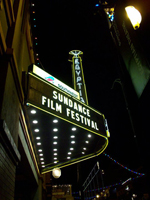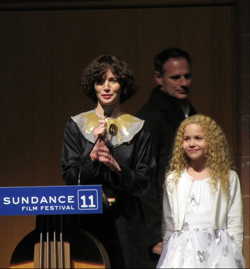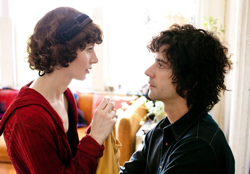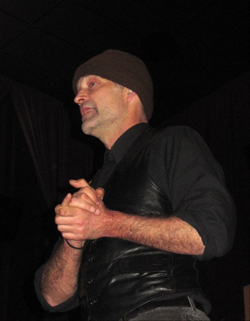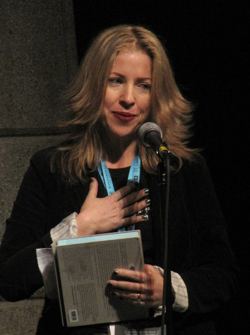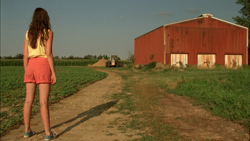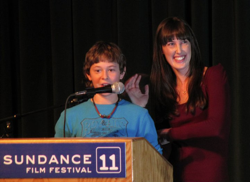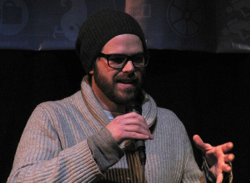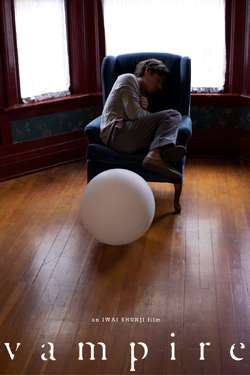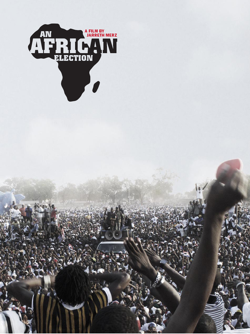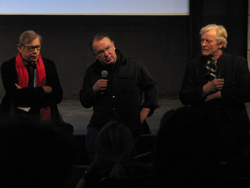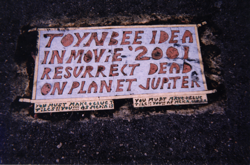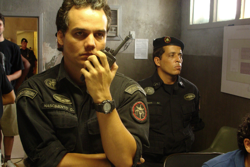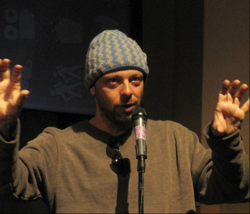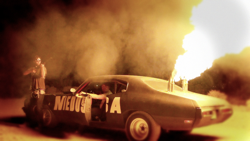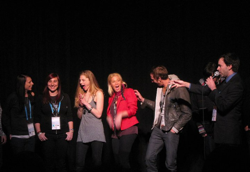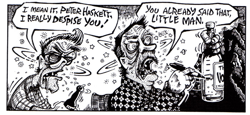The news out of Sundance this year was that business is once again booming. We could tell that things were hopping well before the festival too because the online ticket system was showing many shows as sold out. We may have compounded the effect by shifting our attendance to the opening week of the festival. For the past couple of Sundance’s we had attended the less populated second half. This year, for the first half anyway, it was just plain hard to get tickets. Using the online system during our allotted time slot, weeks in advance of the festival, there were many movies already sold out. Red State, the new movie from Kevin Smith (Clerks) sold out in all time slots in 1 day, including a showing at 8:30 am on a Monday morning.
It should be noted that ‘sold out’ is not the term that Sundance uses. Rather they say ‘wait list only’ as some tickets are held in reserve for walk-ups. Most festivals do it this way because they also have to accommodate pass holders who pay mega-amounts to support the festival and get priority seating. We were able to use the waitlist procedure to get into three films. If you don’t mind the extra risk of not getting in at all this is a cheaper way to attend the festival. Sundance tickets bought online are in the $30 range. It’s not an exact amount because it depends on which package you buy. These tickets don’t actually guarantee a seat (fine print is on the back) but they pretty much do. But walk up to the same theater and get on the waitlist and you’ll pay only $15 if tickets are available. Or someone might walk up and hand you an extra ticket for free. It happens pretty regularly. I’d say the average waitlist line is about 20 people, it could get into the hundreds though for a popular film. In those cases most of the waitlist line will not be getting in. What usually happens though, for the average movie, it seems like most of waitlist gets in.
Using all of our ticket-acquisition moxie we were able to attend 19 screenings, three of those being shorts collections including the Animation Showcase. This was over the period of eight days, interspersed with skiing and finishing with a five movie marathon in the last 24 hours. What could be better? Actually I may have reached the point of burnout as I seemed to have a more cynical view on certain of the movies than did many in the crowd(s) and even the Sundance Jury. I’ll try to make a note of that in the reviews below.
The other advantage to attending the first half of the festival is the extensive list of parties. There are goings-on on main street:
And each film has its own after-party after the initial screening. Here’s me and director Morgan Spurlock at the party for his new documentary The Greatest Movie Ever Sold…
That movie was indeed sold along with 41 other films that found buyers and distribution deals during or immediately after the festival. Last year the number was in the single digits. I didn’t tell him that I hadn’t actually seen the movie. Its focus is product placement in films, hence the NASCAR style apron that Morgan is wearing. Someone needs to tell him to hold that bottle so that the label is facing the camera though.
Did you notice the Southwest Airlines sign attached to the marquee for the Egyptian theater in the picture at the top of this post? Another small piece of Park City was sold off, at least temporarily, as this fictitious insurance office was created to promote the film Cedar Rapids.
Unofficial Festival Theme
Film festivals always seem to have some sort of unexpected theme that shows up in the movies. Sundance always has an environmental bent but this year included a focus on Oregon (and a little bit Washington) in documentaries and in dramas. Here’s what I think is the complete list of films connected to the NW:
If a Tree Falls: A Story of the Earth Liberation Front: centered around Eugene, OR (review below)
Hot Coffee: documentary about how the right to sue is slowly being eroded, Director Susan Saladoff is from Ashland, OR
We Were Here: documentary about the AIDS crisis by Portland director David Weissman
How to Die in Oregon: documentary about the Death With Dignity Act in Oregon
Letters From the Big Man: drama set in SW Oregon, the ‘Big Man’ is Big Foot.
Meek’s Cutoff: drama set in 1845 on the Oregon Trail
The Woods: part of the New Frontiers (meaning avant garde), a comedy filmed in Oregon.
The Oregonian: a suspense thriller set in Oregon
Off Hours: drama about people living in a small town (who also happen to work the late shift), shot and set in eastern Washington (review below)
Catechism Cataclysm: Comedy set and filmed in Washington.
The Future: drama about a young couple anxious about their future together (reviewed below). Filmmaker Miranda July got her start as a performance artist in Portland.
Short Films
As I mentioned above we attended three sets of short film collections this go-round. I still greatly enjoy seeing short films at festivals but one of the reasons to do so was taken off the table at Sundance this year. Most if not all of the shorts were viewable online during the festival. Big budgets are another trend in shorts that I first noticed last year but is on the increase. People with connections and money and possibly an existing deal with a cable channel continue to get short films into festivals. The Beastie Boy’s Adam Yauch had a 30 minute ‘short’ ‘film’ Fight for Your Right Revisited. ‘Long’ ‘Video’ might be more apt terms. Even this partial list of stars that appeared in this project seems about as long as the list of stars in all the other Sundance movies combined: Elijah Wood, Danny McBride, Seth Rogan (those three played the Beastie Boys, re-enacting parts from Beastie’s videos especially ‘Fight for your Right (to Party)’, Susan Sarandon, Stanley Tucci, Roshida Jones, Will Arnett, Rainn Wilson, Ted Danson, Shannyn Sossamon, Steve Buscemi, Amy Poehler, Laura Dern, Alicia Silverstone, Orland Bloom, Kirsten Dunst, Mya Rudolph, Chloe Sevigny, Jason Schwartzman, Will Ferrell, John C. Reilly, Jack Black (those last three playing an older version of the Beastie Boys who travel back in time to have a pissing contest (literal) with the present day Beastie Boys). The contest goes on way too long.
Further constricting the pool of new talent that we might hope to see at a festival is Sundance’s continued selection of films and filmmakers that come out of the ‘Sundance Labs’. I’m rather torn about this. They are surely doing a great thing by nurturing young filmmakers, sometimes with great results. Miranda July whose film The Future was my favorite this year, is a shining example. But the continued selection of filmmakers that they (Sundance) have worked with or continue to work makes the festival more like the showcase for the ‘Sundance Film Studio’. As far as I could tell only two of the films that we saw this year did not come out of the Sundance system.
Pandemic
This was my fourth festival and second nasty cold/flu experience. This one didn’t reach its peak until the week after the festival when I lost my speaking voice. The irony is the way that I caught this one. As part of the New Frontiers exhibit the festival had an interactive exhibit called Pandemic. People were invited to use the electronic displays and associated iphone apps to search for clues as to where an imaginary plague, spreading through Park City at that very moment, had come from. While I’m a little suspicious of the touch screen map that was part of that exhibit I’m fully ready to indict the exhibit that was upstairs from there. On the top floor of an already stuffy, three story house was an exhibit that included two humidifiers attempting to produce enough steam that you could see images projected into it. It wasn’t working for the images but I think this steamy room was the real source of the real pandemic that had about ten percent of each film audience coughing heartily.
MOVIES!!
Ok finally on to the films! I’ve grouped my favorites and some that I most hope people will see at the top of the list here but after that they’re mostly just in the order that we saw them.
The Future
This is Miranda July’s second feature film (her first was Me, You and Everyone You Know). I can’t stop thinking about it. I’ve had the fortune of living in Portland, OR where Ms. July worked as a performance artist long before she got into film. Those performances included abstract elements and often the voice of the artist in different characters. It was apparent then that refining and perfecting the vocal element was something that she valued. In this film Ms. July plays both one half of a young couple in the process of adopting a cat from a shelter and the voice of the cat itself. It’s this vocal performance as the cat (Paw Paw) that is still melting my heart just to think about it. It is tenderness itself. Adopting the cat implies a level of commitment and implications for the future that the couple has to deal with.
In the Q&A following the film Miranda was extremely generous in her discussion of her writing process and the development of the movie. One thing that sticks in my mind was her mentioning of how her father coached her in dealing with feelings as a young girl: ‘I know you’re feeling sad and that hurts but, isn’t sadness interesting?’ Perhaps it is this level of emotional adeptness that allows for the creation of a movie like this. The film contains abstract elements as befitting a performance-artist director and reaches places that few films can match.
Another Earth
Science fiction usually implies a large amount of technical-procedural but it can also mean ‘kick-ass premise for a very human story’. Another Earth fits in that second category. The human story in this case is about atonement. A teenage girl who had been drinking at a party is driving home when she hears the big news; a duplicate of the planet earth has suddenly appeared in the sky. Scientists theorize that it had been hidden behind the sun, exactly opposite our orbit. As she gazes up at that beautiful blue marble, while driving, she crashes her car into that of a young family, killing the mother, child and an unborn child. Only the father survives.
In the Q and A after the film the director revealed that this was yet another film at this year’s festival that was developed in a Mike Leigh style – the script was developed along with the actors over a long rehearsal period. In this case though there are a couple of important divergences from Mr. Leigh’s actual practice. Mike Leigh does actually arrive at a full blown script by the time filming commences and all of the actors are involved. In the case of Another Earth the process was not taken quite as far, there was no final script, and not all of the actors were involved in the process, only the principal parts enjoyed this level of development. Watching the main actors you wouldn’t know about this one way or another because their performances are fine but there are some smaller parts, this young girl’s family for instance, where it’s clear that something is way off. Nonetheless the premise is so good it’s likely you will forget and forgive these shortcomings and recommend this movie to everyone you know which is what I’m doing.
If a Tree Falls: A Story of the Earth Liberation Front
The Earth Liberation Front is the group that claimed responsibility for many of the well publicized pro-environment, anti-corporate ‘actions’ in the 90’s and early 2000’s. The largest and most well known were probably the burning of an under-construction ski lodge at the Vail ski area and the burning of several SUV’s in a new car lot in Eugene, OR. In no case was a person killed or injured, no threats were made against persons though some certainly might have felt that way. The directors started the project when the co-worker of one of their wives was arrested at a New York office building by the FBI. ‘Honey, do you remember Daniel from the office? He was arrested today’. That’s all a documentary film maker needs to hear. Throughout the time when the ELF was active the authorities were thoroughly stymied in their efforts to capture anyone in this group that they had labeled as terrorist. This in spite of the fact that the group had an official spokesman in the media.
This film as an excellent documentation of the origins and history of the ELF and how the FBI eventually was able to arrest many of them. Someone I had met at the festival expressed disappointment saying that the film tried to ‘humanize the terrorists’. Well, they are human. What is in question is whether they are terrorists. The film spends a lot of time on that key question. I didn’t see The Woods which was also at the festival and filmed in Oregon but its web page has this slogan “The Time for Hope has come and gone, now is the time for action”. That’s an echo from the ELF. A lot of ground is covered in this movie and I really hope it gains a wide audience. It should be noted that these NY filmmakers benefited from the invaluable film archive of Eugene, OR filmmakerTim Lewis who perhaps should be given producer credit in this film. He is interviewed extensively in the film and was present in the audience at the
screening we attended.
Connected: An Autoblogography about Love, Death & Technology
If you are a fan of the author Leonard Shlain (Art and Physics, Sex Time and Power, The Alphabet vs. the Goddess) you should see this movie, good luck to anyone who tries to keep you away in fact. If you don’t know Shlain from Cain, you should see this movie. Leonard Shlain was a brain surgeon who came up with some fascinating ideas on multiple occasions. An attempt to explain abstract art to one of his children got him to thinking and eventually writing Art and Physics where he convincingly joins advances in science with corresponding (and generally preceding) major art movements. In The Alphabet vs. the Goddess Shlain postulates that the very act of learning reading and writing altered the human brain in such a way as to predispose us to patriarchal societies, banishing matriarchal societies (Goddess societies) to unwritten history. Intrigued yet? Unfortunately Mr. Shlain left us in May of 2009 although he was working on a final book which I’m sure we’ll see at some point.
This documentary, directed and narrated by his daughter Tiffany, is both a tribute to her father and a plea to humanity to apply the elder Shlain’s way of thinking to solve our problems, collectively. I’m not sure how this movie will play in theaters but it did win a distribution deal. The part of the film that hooks you is the personal story about Tiffany Shlain losing this very special father. The overview of his ideas and our current problems with pollution and overpopulation is too fast moving, not particularly deep. That is probably necessary given the scope of what is covered but perhaps some things could have been trimmed. For example, in what seems like a fit of self-referentialism we are told how two people on the film crew are undergoing hormone therapy. One to aid in conceiving a child, the other as the beginning of a sex change procedure. I think this then led to another hormone discussion and the best part of the movie. I tell you, remember this: There’s a magic number for the duration of hugs. Hugs that last 6 seconds or more cause a release of oxytocin (a magic hormone if there ever was one) in both participants. Highly recommended.
In the Q&A following the film Ms Shlain said that they had a cut without the personal content but the film was flat without it. I could see how that would be the case. So, a personally moving documentary about one’s famous father should be enough for a great film. I’d say it’s a very moving good film, some technical gaffs and the apparent tailoring for a showing on PBS detract from final product a bit. A point of evidence, there are ‘curriculum materials’ available already on the films web site. Still, if you know Shlain, you’ll find a way to see this and be glad you did. If you don’t know this author, the film is a great introduction.
The Off Hours
The Off Hours is a true indie production created by the writer-director Megan Griffiths after working on the script for 10 years. The script got it’s start from Griffith’s observations about working the night shift during her own short stint in a film processing lab. Off Hours takes full advantage of the rainy NW to emphasize the loneliness that comes with that territory. We don’t see much in the way of dramatic turns save for those that come from inside, perhaps after many years of making easier choices.
Ms. Griffiths has worked on many other NW film productions including Hump Day which was at last year’s festival and Catechism Cataclysm which is at this year’s festival. Off Hours is the kind of movie you’d expect from an indie production. It doesn’t soar in any particular way but it does benefit from a strong ensemble cast. There is some excellent low light photography throughout.
You’re half way through – check out more great films in part 2…
Continuing with film reviews from Sundance 2011..
Jess + Moss
This film is an art project that made it. The premise of the film is as much the beautiful location (rural Tennessee) as it is the loosely imposed plot, a young woman with basically a single friend who happens to be a much younger boy, struggles to find her way out of there and onto the rest of her life. As you watch this movie though, you might not be aware that there is a plot at all until the last half hour.
The director set loose a group of friends with cameras and the two principal actors with a tape recorder and then assembled the results. The film was shot on super-16 short ends (unused pieces of film from the ends of rolls). We did hear one other director say their film was shot on film (35mm) during the festival but otherwise it seemed to be all digital. Watching the Super-16 Jess + Moss which is full of saturated colors, made me think that we might be missing more color than we think with all this digital production. Some of the short ends used were of course damaged or otherwise diminished and this is used as part of the art project, adding a hazy, distant, summery quality to the film. One of the hidden gems in this film is an abandoned farm house, the director’s grandmother’s house, where Jess and Moss spend much of their time. Having a production department create this from scratch would have cost many times what was spent on this movie. The house has a collapsed roof, looks likes it’s been through multiple floods and maybe a small fire here and there. Full of junk and valuable antiques, including a working 78 RPM record player, I felt privileged to have this view into a genuine time capsule.
Martha Marcy May Marlene
Perhaps the best way to describe this movie is to quote the director’s intention as stated in the Q&A following the film. He had become aware that a surprising portion of the people he knew and indeed people in general had had some sort of experience with cults. He wanted to capture what it must be like for people in the first weeks after escape from a cult. We follow the main character Martha as she makes her escape and we see what she was escaping from in a series of flashbacks. At times it is hard to separate the flashbacks from the present action and I’m certain this was part of the director’s intent given his statement. The movie plays as a terror-thriller but will leave you as much creeped-out as frightened.
What really makes this movie work is the pitch-perfect performance of Elizabeth Olson, younger sister of Mary Kate and Ashley, as the lead character Martha. Elizabeth was in two movies at the festival, the other was Silent House which seems to have her in a similar role. Add to that the fact that she bears more than a passing resemblance to Jennifer Lawrence, the Oscar nominated star of last year’s Grand Prize Winner Winter’s Bone who herself had a part in another movie at this year’s festival, Like Crazy and yes, it is like, crazy.
The Bengali Detective
When I think about Bengali Detective, a documentary made with the intention of showing what life is like for people living in Kolkata (formerly Calcutta), India I think about what the director of Elite Squad 2 had said: “the only difference between a documentary and a scripted feature is that for scripted movies the script is complete before shooting begins while for a documentary the script is developed as the shooting is done.” I think about that because the documentary The Bengali Detective tells so many stories that is seems like a scripted movie.
The director hit upon the idea of using a private investigator as a window into the lives of ordinary Indians. A genius idea. But he had to find a willing PI first. ‘P’ is for private after all. Fortunately director Philip Cox was able to find the perfect PI in Rajesh Ji. It took some convincing and the PI clients had to go along as well. In general this wasn’t as much as an issue because the clients thought that the film might bring some much needed publicity to their cases. For example, in India 70% of murder cases go unsolved and one case that we watch Rajesh and his team work on is a triple homicide that the local police have no time for.
One of the reasons this film plays like a scripted film is because the director was able to get extraordinary access, not only to the personal lives of Rajesh and his clients but to the local police and jails. It also starts to seem like a scripted film because Rajesh Ji is such a great character, a classic tough man with a big heart, who loves to dance. This one is well worth watching, a deep journey into the lives of modern Indians.
Like Crazy
I keep trying to talk myself into liking this movie. It won the Grand Jury Prize in the dramatic category for Chris’ sake! What’s wrong with me?? I don’t know, you can watch the movie and then tell me. I was not un-moved by this story of young love painfully strained by time and distance. But I cry when I watch Avatar and I don’t even think it’s a particularly good movie. There were some people crying at the end of this one but not me, well maybe a little, so I’ll call it a ‘One Hanky movie’.
I have two main beefs with Like Crazy. One is the style of the movie itself. I heard someone call it mumble-core. I would describe it as MTV-style where we drop in on the main characters every few months and see what’s happening. Character development is not a big part of the plan. If the movie has strong characters to begin with this can work fine. Consider Forrest Gump if you will. That movie covered a large expanse of time between various scenes but it was of interest because we had connected with the goofy but strong main character and probably some others as well. In the case of Like Crazy it’s harder to make that connection. Forrest would have been a welcome addition in this movie come to think of it. I don’t want to give away too much, there’s not much to give away, but it’s the motivations of the male character especially that are hardest to fathom. To me he doesn’t seem to have much skin in the game. Maybe what I saw as a thin script and similar acting were in fact subtleties that were the point of the movie. If that’s the case I needed more from the script and/or certain of the actors to get that. It should be noted that this was yet another film developed in a ‘Mike Leigh light’ manner with only an outline of what’s to happen given to the actors. Anyway, the jury loved it, forget you read this and see for yourself. Jennifer Lawrence (Winter’s Bone) has a small part and is wonderful.
Vampire
Before the film played director Shunji Iwai said that Vampire was a different kind of Vampire movie. A necessary statement I suppose given the genre saturation we are currently experiencing. One main difference is that there are no special effects, no vampire teeth even. The vampire character sleeps at night, is out and about during the day and drains blood from his victims with a needle. Nonetheless, for those who have been keeping up with certain popular vampire or serial-killer series on Showtime and HBO there’s not too much that is new here. I do think this movie has something to say though. It took a while though, thinking about this movie afterwards and discussing it with Secrets’ festival photographer Ray Keller to get it.
This is the second film that this Japanese director has made in English, with American and Canadian actors. Ray pointed out that if this movie had been made with Japanese actors he would have simply viewed it as Japanese people acting in ways that we have seen before, especially the submissive woman character. But by shooting in English with non-Japanese actors the director was able to prevent that viewpoint and instead offer a criticism on certain things he sees in Japanese society. I think I can sum it up this way: There is only one scene in the film that is gruesome and hard to watch. Indeed, it was quite hard to watch, it went on and on and seemed quite degrading to women if not humanity in general. A few people walked out during this scene. Had they stayed to watch the reaction of the movie’s main character they would have at least seen some counterbalance and what I think the director is trying to get at. Something being presented in a movie doesn’t mean it is being endorsed.
Overall the movie was the second most sleep-inducing movie we saw (The Mill and the Cross was number one) as it is in the Japanese-meditative style with beautiful classical piano that the director composed himself. I didn’t actually fall asleep though I’ll have you know. There are some excellent visuals to go with the music, it achieves quite a lot with a tiny budget and cast and is worth seeing.
An African Election
Recent events in Egypt and elsewhere in the Middle East have driven home the fact that many countries around the world, mostly former colonies of the western world, may appear to be democracies but are actually dictatorships propped up by their former colonial masters. The African country of Ghana does not count itself in this category. Rather they are proud of their democracy and stability. But, that doesn’t mean everyone is happy with those in charge. The 2008 presidential elections in Ghana were as heated and as close as those that we have become accustom to here in the US. With remarkable access and scope this documentary shows democracy in action. The film is full of remarkable crowd scenes as the candidates tour the country making their speeches. In the Q&A following the film the director did manage to take a little bit of the luster off of these scenes when he told us that many of the faces in the jubilant crowds were people that would show up and cheer for either candidate, in order to get the free t-shirt. Ghana may be free but they are not rich. Election Day is a national event however and it’s clear that voter participation is not an issue. As I said the election is close and the machinations of the election commission, responsible for certifying the election results are very special treat to get to see. Imagine if a documentary film crew had access to the US Supreme Court for Bush v. Gore. Yeah, imagine. Even in this Ghana case we see the usual suspects bending the rules. I won’t go on any more so as to not give away the ending. I really hope that a lot of children get to see this film, to see what is possible, what it’s supposed to look like. Good for adults too.
The Mill and the Cross
A film inspired by a book dedicated to a single 500 year old painting. The book is The Mill and the Cross – Pieter Bruegel ‘s “Way to Calvary” and as you might surmise the painting is titled “Way to Calvary” though it is also sometimes called ‘Procession to Calvary’. ‘Calvary’ refers to the crucifixion of Christ and so the name refers to the famed ‘Passion of Christ’. Right in the middle of the 4 ft by 5 ft painting there is indeed a depiction of Jesus dragging the cross accompanied by mourners. But there are 500 other people depicted in the painting (I didn’t count them, it came from Wikipedia). So there’s a lot going on. Most pointedly, what is going on is that the Roman soldiers are replaced with the red-coated Spanish soldiers that were occupying Bruegel’s Netherlands at the time the painting was made.
The film picks out a subset of the 500 people as well as the artist and the benefactor that commissioned the painting and expands upon them. You can’t really say that the movie tells us their stories as there is very little dialogue and even less explanation. This film was by far the most likely to induce sleep among the audience of any film at Sundance. It’s a shame that the movie doesn’t offer more story or explanation as it does show some fascinating bits of history. For instance we see women buying loaves of bread and immediately tucking them under their shirts against their bellies. We learned from the director Lech Majewski that this was the custom in order to bring nourishment to future generations, yet to be born. On the other end of the spectrum we see a crucifixion of another kind as a man identified as an enemy of the Spanish invaders is tied to a basket on a pole and is hoisted up to become food for crows. The painting shows only the empty basket, the film shows the man, his wife and the soldiers hoisting him up, and the crows, and the eating. It was only by the director talking to us before and after the film that we learned that the man was an innocent accountant who had refused to convert to Catholicism as required by the invaders.
In spite of all these shortcomings I have bought a copy of the currently out of print book and plan to buy the movie when it comes out on Blu-Ray, presuming that it does. Each scene is a painting unto itself. The amount of work that went into this film is extraordinary. It’s a combination of staged live action and CGI created over a two year period. Emblematic of the work involved, to get film of clouds that resembled those in the painting, a crew was dispatched to New Zealand. Rutger Hauer plays Pieter Bruegel and Michael York plays the benefactor. Both were in attendance at the screening. Mr. Hauer is making his bid for most versatile actor working today as his other film at the festival was Hobo with a Shotgun (he plays the title role). Maybe he’s working as a producer and director a little bit too as he enlisted some help from the audience in filming other members of the audience during the Q&A. I volunteered Ray for this duty and then took grainy pictures of it so I’m not bothering to post them. I did manage to get some decent shots of the director Lech Majewski along with Rutger Hauer and Michael York.
Resurrect Dead: The Mystery of the Toynbee Tiles
In the early 1980’s hundreds of tiles bearing the message: Toynbee Idea in Movie 2001. Resurrect Dead on Planet Jupiter began to appear, embedded in traffic lanes of streets, in cities on the east coast of the US and in South America. What the?? The message itself is correct on its face, an idea mentioned almost in passing by the historian Arnold Toynbee: That science might someday progress to the point where deceased humans could be reconstructed in a living state molecule by molecule, was used in 2001 A Space Odyssey. Why and how this message began appearing in artfully designed linoleum cut-out tiles, in the middle of streets, is the focus of the film.
This film somewhat exceeds its actual subject matter because it is well constructed and edited and has a great score. The director told the audience that it was a ‘cold submission’ to the Sundance festival, meaning that the film was not in any other festivals and the director hasn’t had any previous films at the festival or workshopped his ideas in the Sundance labs so getting into the festival at all is a testament to how well made it is.
The film primarily follows artist Justin Duerr (shown here at the Q&A following the film) who encountered these tiles in the 80’s and began his pursuit of the mystery. The artfulness of the tiles themselves was part of what lured him. Justin in turn brought some of his artwork to Sundance with the hopes of gaining an audience and making some sales.
Elite Squad 2
The title makes this sound like a terribly straightforward cop movie, especially the ‘2′ part. Describing the plot – one tough, honorable cop trying to weed out corruption, just so happens that his ex wife is married to a popular college professor who rails against harsh police tactics in the media, even this sounds rather familiar and probably too contrived. But this movie is not even in the same category as the typical cop movie. One thing that raises this movie above most is the excellent execution. Tight performances and directing throughout the film make it really sing. Then there’s the fact that the director is doing his best to portray what is actually happening in Rio de Janeiro, Brazil and to move public opinion.
Rio has terrible problems with various slums throughout the city, ruled by various drug lords. They may ‘rule’ but they don’t have what you would call an easy life. They are subject to graft by corrupt police officers who of course can act in any way they please with impunity. The media is also firmly on the side of the police, anxious to play up the need for harsh crackdowns. The problem in actual life and in the movies even is that harsh beatings (or worse) of the bad guys don’t seem to have any positive effect and rather seem to draw in the sort of police officers who would not only execute the beatings but then use the opportunity to collect a percentage. I say it’s a problem in the movies as well real life because the first Elite Squad had the same public-opinion agenda as Elite Squad 2 but the director failed to account for the fact that viewers might just take the bad-guy-beatings as a good thing and leave it at that. In the Q&A director Jose Padilha said that he had to make ‘2′ because people weren’t getting his meaning, that the police were out of control. It’s worth seeing even without seeing part one, whether you live in Rio or not.
Bellflower
A post-apocalyptic love story. Not actually set in the post apocalypse. Two friends are channeling their fetish for muscle cars and flame throwers into readiness for when Mad Max rules the road. When one of the pair starts a romance at a bug eating contest in a bar, the apocalypse starts to seem far away. Until the relationship goes bad that is. Not for the faint of heart but not without a heart of its own. Shot over a generous 90 days by a group of friends in Oxnard and Ventura, California. Director Evan Glodell was actually customizing the muscle car (looks like a 70 or so Chevelle SS) during the course of the shooting so the automotive work was filmed as well and is used in the movie. The same ingenuity and DIY muscle was applied to the camera as well, the director fashioned custom optics to amend the camera lens filling the film with colored, hazy images at just the right times. Seems like these custom optics were hard to clean though as there was often dust left on the lens, showing up later as large blotches when the film is projected. But those and some similar audio gaffs seem to fit in a movie that plays it rough on all fronts.
Shut Up Little Man
In 1987 two guys from Wisconsin moved to a thin walled apartment in the Haight district of San Francisco. They discovered that they had some special neighbors. Peter J. Haskett and Raymond Huffman were aging alcoholics with a penchant for vicious verbal arguments lasting late into the night. “Shut up little man” was the most common and least offensive of the verbal barbs. The Wisconsin pair (Eddie Lee Sausage and Mitchell D.) began recording the over-the-top arguments. Copies of the recordings went viral (in the pre-internet sense) and were adapted into comic books and both a theatrical and movie production. This film is a documentary of those events and some of the subsequent copyright scuffles.
The film works well as both a thorough document of the original arguments, which when played back as part of the film are hilarious up to a point, and the subsequent viral phenomenon. On the copyright front there were several parties vying for the rights and the film shows some reunion-style, present day conversations between those people and this is where the film came up short for me. These conversations just aren’t very interesting. They look like people being nice to each other for the sake of the camera but if it weren’t for that they wouldn’t even be bothering to talk to each other. The more interesting aspects of the copyright story are the conversations with Peter J. Haskett himself though these are tinged with sadness as this was a man who lost his life to alcoholism. There also seems to be a larger question of whether the Wisconsin pair had any right to distribute the original tapes even though it was done informally and not for profit. Personally I feel that if someone is screaming in the neighboring apartment at 2am they have forfeited their rights, drunk or not. If you can manage to make something even mildly entertaining out of it you should win a prize.
But as the movie goes on it gets harder to laugh at the craziness of the fights and harder to overlook the human tragedy of these lives. In the Q&A the director told the audience that there was an unconfirmed report that Peter J. Haskett was a 1960’s advertising executive (as in Mad Men) and had worked on the JFK presidential campaign, succumbing to alcoholism after the assassination. Whatever lives these men had it was clearly a long hard fall. There are many ambiguities surrounding the Shut Up Little Man phenomenon and this film involves the viewer in all of them.


